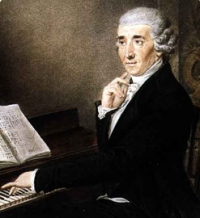Haydn Sheet Music
 Franz Joseph Haydn (March 31, 1732 – May 31, 1809) was one of the most prominent composers of the classical period, and is called by some the "Father of the Symphony" and "Father of the String Quartet".
Franz Joseph Haydn (March 31, 1732 – May 31, 1809) was one of the most prominent composers of the classical period, and is called by some the "Father of the Symphony" and "Father of the String Quartet".A life-long resident of Austria, Haydn spent most of his career as a court musician for the wealthy Hungarian Esterházy family on their remote estate. Isolated from other composers and trends in music until the later part of his long life, he was, as he put it, "forced to become original".
Although Haydn is still often called "Franz Joseph Haydn", the composer did not use the name "Franz" during his lifetime and this misnomer is avoided by modern scholars and historians. Joseph Haydn was the brother of Michael Haydn, himself a highly regarded composer, and Johann Evangelist Haydn, a tenor.
A central characteristic of Haydn's music is the development of larger structures out of very short, simple musical motifs, often derived from standard accompanying figures. The music is often quite formally concentrated, and the important musical events of a movement can unfold rather quickly.
Haydn's work was central to the development of what came to be called sonata form. His practice, however, differed in some ways from that of Mozart and Beethoven, his younger contemporaries who likewise excelled in this form of composition. Haydn was particularly fond of the so-called "monothematic exposition", in which the music that establishes the dominant key is similar or identical to the opening theme. Haydn also differs from Mozart and Beethoven in his recapitulation sections, where he often rearranges the order of themes compared to the exposition and uses extensive thematic development.
Perhaps more than any other composer's, Haydn's music is known for its humour. The most famous example is the sudden loud chord in the slow movement of his "Surprise" symphony; Haydn's many other musical jokes include numerous false endings (e.g., in the quartets Op. 33 No. 2 and Op. 50 No. 3), and the remarkable rhythmic illusion placed in the trio section of the third movement of Op. 50 No. 1.
Search for Free Sheet Music
You can make a search through the entire collection of sheets.
You can make a search through the entire collection of sheets.
Latest Artists
Brahms
× 9
Atie Bernet × 2
American square dance × 1
Neftali Medina × 1
Bill Evans × 3
Nemesio S. Que × 1
Chick Corea × 1
Lauv × 1
Vytauto Kernagio × 1
Huub de Lange × 2
Li Yilang × 1
Louis Armstrong × 3
Steve Nelson × 1
Rent × 1
Duffy × 1
Luis Pedro Bedmar Estrada × 1
Bill Holman × 1
Cat Stevens × 3
Traditional × 61
Dolores O'Riordan × 1
Elton John × 3
Coldplay × 2
Edvard Grieg × 1
Lennie Tristano × 1
Valter Bresolin × 1
George Friedrich Händel × 1
Prokofiev × 2
Herbie Hancock × 1
Louis Couperin × 1
The Academy Is × 1
Arlene Schwartzkopf × 2
Giuseppe Cappotto × 1
Grieg × 1
Jan Akkerman × 1
Robert Williams × 1
Rudolf bial × 1
Tom Beek × 1
Trova Yucateca × 1
Brenda Lee × 1
James Dees × 1
Nguyen Duy × 1
Sandy Wan × 1
Benny Davis × 1
Green Day × 1
Leopold Mozart × 1
Toots Thielemans × 1
Bob Elgin × 1
Rob de Nijs × 1
White Shadow × 1
Donald Patriquin × 1
Atie Bernet × 2
American square dance × 1
Neftali Medina × 1
Bill Evans × 3
Nemesio S. Que × 1
Chick Corea × 1
Lauv × 1
Vytauto Kernagio × 1
Huub de Lange × 2
Li Yilang × 1
Louis Armstrong × 3
Steve Nelson × 1
Rent × 1
Duffy × 1
Luis Pedro Bedmar Estrada × 1
Bill Holman × 1
Cat Stevens × 3
Traditional × 61
Dolores O'Riordan × 1
Elton John × 3
Coldplay × 2
Edvard Grieg × 1
Lennie Tristano × 1
Valter Bresolin × 1
George Friedrich Händel × 1
Prokofiev × 2
Herbie Hancock × 1
Louis Couperin × 1
The Academy Is × 1
Arlene Schwartzkopf × 2
Giuseppe Cappotto × 1
Grieg × 1
Jan Akkerman × 1
Robert Williams × 1
Rudolf bial × 1
Tom Beek × 1
Trova Yucateca × 1
Brenda Lee × 1
James Dees × 1
Nguyen Duy × 1
Sandy Wan × 1
Benny Davis × 1
Green Day × 1
Leopold Mozart × 1
Toots Thielemans × 1
Bob Elgin × 1
Rob de Nijs × 1
White Shadow × 1
Donald Patriquin × 1


































